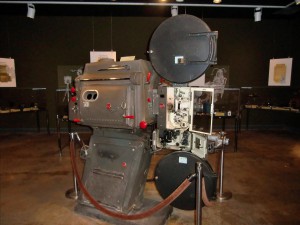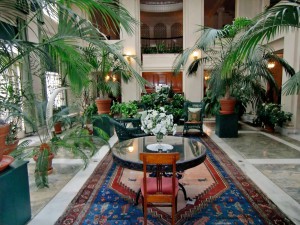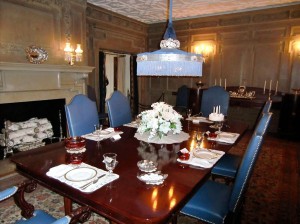EXPLORING NEW YORK – ROCHESTER AND EASTMAN KODAK
EXPLORING NEW YORK
This is the ninth in a series of articles about traveling the byways of New York State
ROCHESTER AND EASTMAN KODAK
By Charles N. Stevens
Photos by Dolores Seidman
We wake up to a wild sky this morning, a ragged swath of clouds leaning out of the north. A blue band of clear sky lies on the western horizon. By the time we board the bus a chill wind penetrates us to the bone and whips an American flag close by.
As we enter the circular driveway of the grand Eastman Estate in Rochester the rain begins, the bus’s windshield wipers sweeping and squeaking. George Eastman was an innovator in the field of photography and film and the developer of the Kodak Company. A wet wind thrashes the trees as we step into the comfort of his ivy-covered mansion. His home, with additions, is one of the finest museums of photography and its development in the world.
We first visit a large room displaying a wide variety of cameras, from simple brownies to gigantic movie cameras. The largest machine in the room is a projector once used for a drive-in movie theater. There are hüpfburg colorful toy cameras as well as cameras owned by famous photographers such as Alfred Stieglitz and Joe Rosenthal. Old and new cameras provide a clear picture of their development. On the wall are famous photographs—One is of Marilyn Monroe, another the raising of the flag on Iwo Jima and still another of immigrants emerging from a ship’s steerage after crossing the Atlantic.
Out in the hallway is an amazing mosaic composed of hundreds of small photographic negatives of different shades of black and white that form the face of George Eastman. From a distance we see his portrait clearly, but if we look close up it’s just a series of negatives that makes no sense. Other displays that would interest photography buffs are about silhouettes, salt prints, Daguerreotypes, tintypes, albumin prints and Polaroid.
After enjoying the museum we tour his palatial home, a 35,000 square foot home built as an urban farm. Eastman was never married, and lived in his house alone with his servants. At one time he could gaze out of his fortress-like house at Jersey cows, horses and vegetable gardens. Today, we look out on formal gardens with low hedges forming geometric designs. Eastman was born in Utica, New York but moved to Rochester in 1860. Like many self-made men, he had dropped out of school at age 13. He invented the dry plate process of developing film and went on to patent twenty-seven more processes.
We begin our home tour in the dining room where the table is set for twenty-two guests. Plates are arranged in order and the glassware gleams. A white ceiling and wood-paneled walls comprise a cozy atmosphere.
The well-lighted conservatory with its large potted plants is overlooked by a huge stuffed elephant’s head gazing outward, its trunk drooping and its tusks curving menacingly outward. A pipe organ here is capable of filling the conservatory with pulsing sound. The excess in the conservatory might be attributed to “a poor boy becoming rich.”
Next is the game room with its solid pool table. On a nearby table stands a flower vase fashioned from the foot of an African antelope. Eastman loved to hunt and went on several safaris, bringing home souvenirs of his exploits. I personally am appalled by how many animal parts are used for vases, waste baskets and trays throughout the house.
We stroll under the great chandelier in his living room then walk by his grand piano and collection of violins, admiring the opulence that surrounded Eastman and wondering about a person having all this to himself.
Eastman was a shy man, finding it difficult to deal with other people. Having no heirs, he gave all his money away to hospitals, medical schools and dental dispensaries in Rochester and around the world. Sadly, he shot himself, proclaiming before hand that, “My work is done, why wait.”
On the bus again in blustery weather, we head for Buffalo. We’re on Interstate 490, the scenery along the highway bland and bare, lacking the charms of smaller roads that wind through farmland and small towns.
On the outskirts of Buffalo we see something that we would never see in California, a large shed housing a pyramid of rock salt, ready for laying down on icy roads in the coming winter. Near a freeway ramp where we turn off to the city, a bronze buffalo grazes in the grass. Later we find these large plastic buffalos all over town, many painted in different, often spectacular, ways.
With a guide, we begin our tour of Buffalo. Most interesting to me, just outside the main part of town, is a Seneca Indian burial mound, a sweep of grassy ground where the wind rustles yellow leaves. As if on cue, a deer walks through the sight. A special plaque honors Red Jacket, a Seneca chief.
Our guide tells us that Buffalo has a large Irish population as many of their forbears worked on the Erie Canal, the railroad and the steel mills. Buffalo was a transfer point for goods brought in from Great Lakes ships to be placed on Erie Canal barges.
Near the water and docks, looking bleak in the light rain, stand huge grain silos, many of them now abandoned. The General Mill plant nearby produces Cheerios, the smell of the baking cereal pervading the air. We pass the trolley barn, the streetcars traversing only the main street of town.
Our swing through the town is a whirlwind tour, the buildings passing in rapid succession—churches, hotels, businesses, the Millard Fillmore Hospital, old mansions, special neighborhoods and many establishments found in any town.
The highlight of the day is a trip into Canada to view Niagara Falls at night. Powerful red, blue and yellow lights play on both the American and Canadian falls, giving them an eerie look. I think I would prefer white light.
I’m taken with the majesty of it all, the dark water pouring over the cliff, thundering below, the spray creating a cloud of mist that drifts south in the breeze. The water from the American falls crashes onto boulders, breaking up among them into foamy, cascading streams and rivulets. We bundle up in the cold as we gaze at the spectacle—being at one with the moist chill and roar of the falls.

At the fine museum attached to the Eastman house are a variety of cameras such as this one used in a drive-in movie.

This restful conservatory is at the center of the house. Not shown is the head of an elephant overlooking the room.

The dining room table is set as though the guests were about to arrive.

Eastman's spacious living room invites one to sit down and read a good book.



